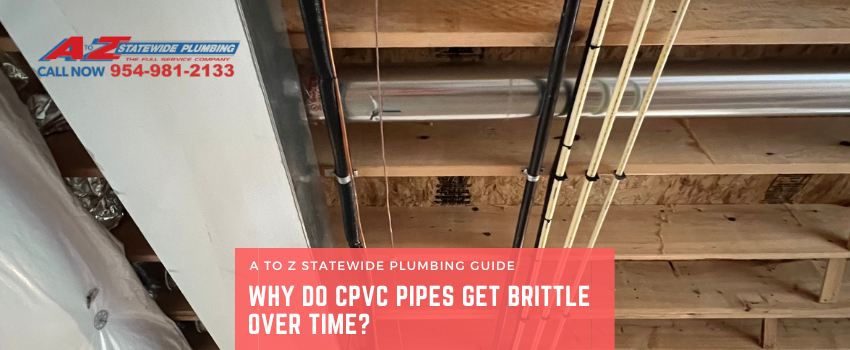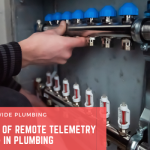 At A to Z Statewide Plumbing, our technicians often ask why CPVC pipes get brittle over time? Let’s break it down – like plastic under pressure.
At A to Z Statewide Plumbing, our technicians often ask why CPVC pipes get brittle over time? Let’s break it down – like plastic under pressure.
1. Chlorine Degradation
Did you know the very thing that disinfects your water can eventually break down your pipes? Here’s what happens: water treatment plants use chlorine and chloramines to kill bacteria, but these chemicals slowly react with the CPVC. Over years, they slice up the long plastic molecules, making the pipe’s structure weaker and rougher. You’ll rarely notice this happening, but after a decade or more, those little cuts add up. The result? The pipe walls get crumbly in spots, especially where chlorine levels are highest—like near your water heater, or if you flush your system often.
2. Plasticizer Loss & Aging
Imagine CPVC as a loaf of bread that starts soft but dries out in the sun. CPVC doesn’t have much of those “softeners” (plasticizers), but what it does have can slowly leach out—especially in hot, dry conditions. As these components vanish, the pipe’s surface changes from flexible to brittle, like a dry twig snapping in the wind. This process happens even faster if your home runs really hot water or sits in a scorching attic.
3. Environmental Stress Cracking
Here’s where your choice of plumbing products really matters. If CPVC is paired with the wrong type of thread sealant, pipe dope, or even routine household cleaners that drip onto the surface, it can cause chemical reactions. These create tiny, invisible cracks at first. Put any pressure on a bent or hanging section, and those microcracks start to spiderweb throughout the pipe. Over time, what was once a tough plastic becomes a weak spot just waiting to burst.
4. UV Exposure
Even if your pipes aren’t sunbathing outside, they aren’t safe from light! UV rays sneak through attic vents, skylights, or windows, breaking down the outer shell of the CPVC. At first, you might just notice discoloration—maybe a yellow or brown tint. But the real damage is deeper: the surface gets chalky and brittle, losing its toughness and ready to crack at the slightest bump.
5. Thermal Cycling
Every day, your pipes expand when they’re warm, then contract as they cool off—like a bridge moving on a hot summer day. Every hot shower, attic heat wave, or cold snap is like bending a paperclip back and forth. It doesn’t break the first hundred times, but give it months or years…and snap! These tiny, ongoing stresses slowly chip away at the pipe, especially at joints and fittings.
Bottom Line:
CPVC isn’t fragile out of the box, but life happens. Water chemistry, heat, light, chemicals, and stress—they all team up over the years to make CPVC less reliable. That’s why older pipes, or those in rough environments, can reach a point where they fail faster than most people expect.
Worried about brittle CPVC pipes? You’re not alone! Let’s talk about smart alternatives, simple fixes, and awareness every homeowner and builder should have. Ready for peace of mind? There are better picks than CPVC:
PEX: Flexible, durable, and almost immune to chlorine and most common household chemicals. It’s like giving your home a set of yoga pants—moves with the flow, resists cracking.
Copper: The classic! Long-lasting, resists UV and heat, naturally antimicrobial. The truth is… copper’s higher cost pays off with dependability.
Stainless Steel: Super strong and corrosion-resistant. It’s the body armor of plumbing, but usually for high-end work.
Best practices if you already have CPVC installed:
Don’t panic—just get proactive!
Regular water testing: Check for chlorine levels. High chlorine? You’re speeding up pipe aging. Use home water test kits or ask a plumber for help.
Know when to replace: If pipes near heaters feel chalky, snap easily, or show discoloration—consider replacing those hot zones first.
Use compatible products: Only use approved thread sealants and avoid harsh chemical cleaners near piping.
Protect pipes from UV: Wrap or shield exposed pipes, especially in attics or sunny rooms.
How can A to Z Statewide Plumbing help?
A to Z Statewide Plumbing knows how to spot early warning signs—before pipes break. We use the right products, the right repairs, and up-to-date inspection methods to protect your pipes from every one of these risks. Want peace of mind (and avoid a water disaster)? Reach out and let the pros handle it. Remember: everything you want—a worry-free plumbing system—exists on the other side of a good inspection!






